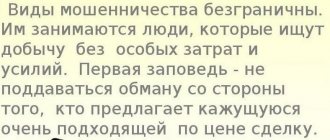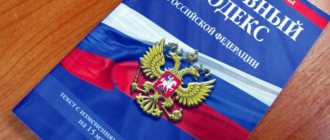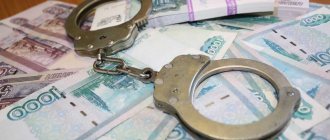Counterfeiting is one of the oldest types of crimes. It appeared from the time of the first money in the form of coins, and even then it was severely punished by the authorities.
The people in Russia, just as they lived poorly 500 years ago, live so poorly to this day. At the same time, he actively comes up with various ways to obtain wealth without burdening himself with legitimate labor.
Today, thanks to the rapid development of modern technologies, counterfeiting money has become much easier, but identifying such counterfeits is not particularly difficult for the authorities.
Counterfeiting under Art. 186 of the Criminal Code of the Russian Federation refers to types of crimes in economic activity, and is called a little differently - “Manufacture, storage, transportation or sale of counterfeit money or securities.”
Counterfeiting: concept and legal features
Counterfeiting is the counterfeiting of money. The crime includes the production of counterfeit banknotes, their storage, transportation and sale.
Crime under Art. 186 of the Criminal Code of the Russian Federation is considered completed from the moment the bill is made, even if it has not yet been sold.
The production of money presupposes the presence of special laboratories and devices with the help of which fake money is produced en masse.
Counterfeiting can occur either partially or completely . Partial counterfeiting of money is a change in serial numbers or the application of any signs. Complete counterfeiting is the creation of banknotes from scratch.
Selling fake money is an attempt to put counterfeit money into circulation. Counterfeiters try to buy something in stores, change banknotes in stalls where machines for checking the authenticity of banknotes are not installed.
So, the following financial instruments can be considered as money:
- Bank notes of the Bank of Russia;
- Metal coins;
- Securities in domestic or foreign currency: shares, bonds, bills, checks, etc.
Moreover, the crime applies not only to those monetary units that circulate freely on the market, but also to those that have been withdrawn from circulation and are subject to exchange for other banknotes.
How to correctly qualify the crime?
The issue or release of funds is a function of the state, namely the Bank of Russia. No one else can issue money.
Money is not just pieces of paper; it must be backed by the country’s gold and foreign exchange reserves. Unsecured funds have no value and should be immediately withdrawn from circulation.
So, the crime of counterfeiters looks like this:
- The subject is various types of banknotes and securities, the production of which was illegal.
- The object is economic and social relations, as well as the status of the country's monetary system.
- The objective side presupposes the presence or absence of laboratories for the production of money in the crime, the period of work of counterfeiters, and options for selling banknotes. It is not at all necessary that the criminal pay with a counterfeit bill. He can transfer it to someone else or repay a debt to a friend with fake money.
- To be attracted under Art. 186 of the Criminal Code of the Russian Federation can be a subject who has reached the age of 16 years and is recognized as sane. A person who became the owner of a counterfeit banknote, of which he was aware, but did not produce it himself, may also be brought forward as a suspect in the case.
- The subjective side of the criminal act involves direct intent to sell counterfeit products. If there is no sales purpose, there will also be no criminal charges.
If a new buyer or owner of a counterfeit sells it on the market, the crime will be classified as aiding the sale. And if the sale of the bill does not happen for any reason, this act will already be recognized as preparation for sale.
An attempt to sell a counterfeit banknote will be recognized as an act in which the seller refused to accept a means of payment, regardless of the reasons for his behavior.
That is, even if the seller simply does not have change and therefore does not sell you the goods, your behavior will be recognized as a criminal attempt to sell.
Methods for making counterfeit money
In order for a person to become the subject of a crime, he must forge at least one copy of a banknote or security.
Such inventors are usually caught in sales . They reliably guard their clandestine laboratories, without arousing the suspicion of others and law enforcement officers.
If the place of manufacture is closed by the police, they will be charged with manufacturing, storage, and sales. If a criminal is caught selling banknotes, then only sale.
There are three ways to make counterfeit signs:
- Manual method;
- Computer method;
- Using special cliches.
The manual method has practically become obsolete today, and the computer method and the method of casting real cliches are widely practiced, both separately and together.
Object of counterfeiting
Such an object is considered to be relations in society that develop in the monetary sphere of our country or other countries when it comes to the production of counterfeit foreign money. Any money is issued only by a specialized state organization. This right is protected by law.
Counterfeiting, like any other crime, must be qualified. For this, it is very important what exactly in this case is the subject of the crime. It can be:
- tickets of the Central Bank of the Russian Federation;
- metal coins;
- securities having value in the state currency of the Russian Federation;
- foreign money;
- securities having value in the currencies of other countries.
Any of the above valuables can be counterfeited. This is the essence of the counterfeiting process. The very concept of “fake” has the meaning of “unofficially manufactured,” that is, counterfeit. Usually, criminals counterfeit exactly the money that is currently in use and can be easily handled. In this case, absolute external compliance is maintained. A thin, high-quality fake is a criminal crime.
If criminals make money that is no longer in use, or that is of interest to collectors, this crime is considered fraud. The same violation will be qualified when a fraudster tries to sell a very crude counterfeit that an ordinary person can notice.
Term for counterfeiting
Types of liability and penalties are prescribed in parts 1, 2 and 3 of Art. 186 of the Criminal Code of the Russian Federation. The choice of punishment is made based on the circumstances of a particular crime. Below we will describe in detail how much they give for counterfeiting money.
Thus, the habitual production, storage, sale or transportation of counterfeit money is punishable by one or more of the following penalties:
- Forced labor for up to 5 years;
- Imprisonment for up to 8 years;
- Fine up to 1 million rubles;
- Fine in the amount of the convicted person's income for up to 5 years.
The same crime, but committed on a large scale, provides for liability:
- Imprisonment for up to 12 years;
- Fine up to 1 million rubles;
- Fine in the amount of the convicted person’s income for up to 5 years;
- Restriction of freedom up to 1 year.
In this case, fines and restriction of freedom act as additional types of punishment.
A large crime implies that the denomination or value of the goods purchased with counterfeit money exceeds 1 million 500 thousand rubles.
Identical criminal acts, but committed by an organized group of persons, are punished in accordance with the Criminal Code of the Russian Federation:
- Imprisonment for up to 15 years;
- Fine up to 1 million rubles;
- A fine in the amount of the convicted person’s income for a period of up to 5 years;
- Restriction of freedom up to 2 years.
If counterfeit banknotes do not participate in the circulation of funds, and clearly do not correspond to the original money, and are created to mislead a certain group of people, then such an act can be qualified as fraud.
Forms of counterfeiting
This crime can be committed in the following forms:
- money is produced for the purpose of subsequent sale;
- securities and coins are stored and transported for the purpose of subsequent sale
- direct sale of counterfeit monetary values.
Fraudsters may also produce money that is only partially counterfeit. Namely, during the examination the following were discovered:
- counterfeit banknote or bond number;
- counterfeit series of securities;
- changed denomination of the banknote.
After making counterfeits, criminals try to sell them in different ways. They put them into use by making purchases, exchanging, borrowing. The criminal may also present a bond or check for payment.
If you need to get an answer to your question, you can ask it to lawyers online or consult by phone
Judicial practice and statistics
The fight against counterfeiters is not only a problem for Russia. All over the world they are actively fighting this phenomenon.
In this regard, as part of a preventive policy to prevent counterfeiting, the International Convention for the Suppression of Counterfeiting of Currency was adopted in 1929.
In our country, this act has been ratified, which means that we act within the framework of the document.
In Russia, in the Resolution of the Plenum of the Armed Forces of the Russian Federation No. 2 “On judicial practice under Art. 186 of the Criminal Code of the Russian Federation" states that such crimes significantly undermine the authority of the local currency and create huge problems in controlling money circulation.
Resolution of the Plenum of the Armed Forces of the Russian Federation No. 48 indicated that any illegal manipulations with electronic money, computer programs that carry out money transfers, the motive of which is the commission of crimes such as theft, fraud, etc., in cases where the crime has not ended , will be considered under Art. 186 of the Criminal Code of the Russian Federation.
Based on statistics published by the Ministry of Internal Affairs of the Russian Federation, money in our country is practically not counterfeited on a particularly large scale.
Therefore, the majority of cases end with a sentence of 2-5 years in prison. Moreover, in 60% of cases the punishment is suspended.
In more than half of the cases under Art. 186 of the Criminal Code of the Russian Federation, judges impose penalties for criminal acts. A term of more than 10 years of actual imprisonment was recorded in only 1% of cases in such criminal cases.
According to the Central Bank of the Russian Federation for 2021, counterfeiters most often counterfeit banknotes with a face value of 1,000 rubles. or 500 rub. Hundred-ruble or fifty-ruble bills are practically not counterfeited in the country.
Counterfeiting is an economic criminal offense committed for the express purpose of profit and material gain . Such acts are always associated with an attempt to sell manufactured counterfeit products.
Now the number of such crimes has decreased significantly, which is due to a reduction in cash circulation in the country and the creation of requirements for control over the circulation of funds.
Each store today is equipped with a special device that allows banknotes to shine through; the number of spontaneous markets and stalls has decreased significantly. However, the problem is still acute.
Even if all cash disappears from circulation, criminals will learn to forge digital signatures, steal passwords from accounts, and will again continue to steal other people’s money.
Video: Counterfeiting
Manufacturing, storing, transporting or selling counterfeit money or securities
The subject of the crime in question is a counterfeit ticket of the Central Bank of the Russian Federation, metal money in circulation (in some cases, seized from it). For recognition, it is worth considering certain points; they are represented by three main conditions:
- sign No. 1 – withdrawal from circulation or actual circulation;
- sign No. 2 – banknotes are counterfeit, and the method of counterfeiting them and the equipment that was used for this do not play a role;
- the third important parameter is quality, that is, similarity to the original versions, which does not allow one to identify a fake with the naked eye (we are talking about such basic parameters as color, shape, size).
That is, when a violation is mentioned, we are talking directly about the counterfeiting and sale of banknotes of the Central Bank of the Russian Federation and coins, as well as the Central Bank. That is, the same transactions with Soviet money or chervonets cannot act as subjects of crimes. In this case, the legal framework on which representatives of the law rely in order to determine punishment is Art. 159, according to which the act is qualified as fraud.
In the process of resolving the issue related to the presence or absence of signs of an act under Art. 186 of the Criminal Code of the Russian Federation, one important point should be taken into account. It has to do with whether the “counterfeits” are truly fake (obviously) or bear little or no resemblance to the original bills. If they are transferred to a limited list of persons, this act is regarded as fraud, since a specific person is being deceived, and the counterfeit banknote does not correspond to the original.







